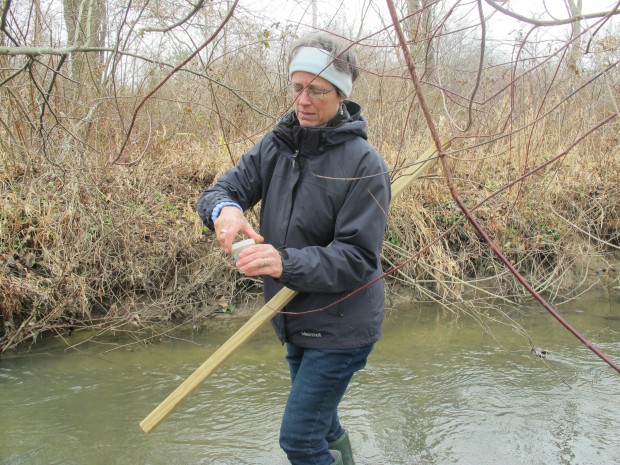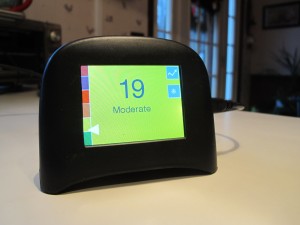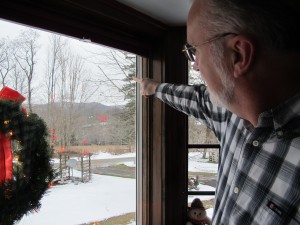Gas drilling draws citizen scientists to the field
-
Katie Colaneri

Joanne Martin collects a sample of water from Brady Run, a stream in South Beaver Township in western Pennsylvania. She is a citizen scientist monitoring the water for potential pollution from nearby natural gas drilling.
Joanne Martin stands on the muddy bank of Brady Run, a stream in Beaver County in western Pennsylvania. To get there, she crawled down a steep gravel slope, ducking low tree branches and stepping over dead brush.
Martin has been coming to Brady Run for three years to test the water for signs of pollution from natural gas drilling. There’s a producing well pad just about a half a mile from here.
First, Martin plunks in a wooden measuring stick to check stream depth.
“Then, I go upstream a little bit because I don’t want to take water from where I disturbed the sediment,” she says. “I don’t want any of that in the sample.”
She takes a small cup, the kind you might use at a doctor’s office, and dips it into the stream, bracing herself for the icy water.
Back on the bank, Martin uses a pocket-sized monitor to test her sample. It’s measuring the conductivity of the water. A higher conductivity reading than usual could be a sign that metals are discharging into the stream, possibly as the result of a spill of the salty flowback water that comes up out of a well after it has been hydraulically fractured or fracked.
Martin is not a professional scientist. So why is she standing in the middle of a frigid stream on a December morning?
Across the country, the shale boom has given rise to fears about whether oil and gas development might be polluting the water we drink and the air we breathe. This has led some residents to try doing their own field research, in the mode of “citizen science.” But unlike the annual Christmas Bird Count or a website to help astronomers catalog billions of galaxies, their work is a tricky blend of science and advocacy.
“We need more boots on the ground”
Julie Vastine is Director of the Alliance for Aquatic Resource Monitoring based out of Dickinson College. ALLARM started in 1986 enlisting the help of average citizens to monitor streams for the impacts of acid rain. Since the early 2000s, the program has encouraged citizen science to help communities answer their own questions about the health of their local watersheds.
Then, the shale boom hit. Vastine says the big question lately has been how all the drilling and fracking and laying of new pipelines might be affecting thousands of miles of Pennsylvania’s streams.
“There are limited resources by state agencies, regional agencies to do monitoring, so it’s obvious that we need more boots on the ground to be able to collect water quality data,” she says.
Today, ALLARM has more than 500 volunteers using monitoring tools to sample streams in Pennsylvania, New York and West Virginia. All of them have been trained in the program’s strict protocol to detect pollution and to report problems to state regulators. According to Vastine, volunteers have reported 42 potential violations, including several cases of stream erosion and methane migration, which can show up as pockets of bubbling in waterways.
About 85 percent of ALLARM’s volunteers are working in places where gas drilling has not yet started and are collecting baseline data for the future.
Vastine says some people are drawn to the program because they like being part of scientific research. Others – like Joanne Martin – got involved out of worry about fracking’s impact on the environment.
“When I first started testing I thought, ‘Wow, this would be a perfect opportunity to really ring the alarm bells and maybe halt the whole production if we actually were to find some contamination in the stream,” Martin says. “And really, in the end no, I don’t hope that that happens, but sometimes those are the ways to call attention is when there is a problem.”
That’s the key for people like Martin: They want the data they’re collecting to get regulators and politicians to pay attention.
“If you have facts, you can send it in and say, ‘We want this reported.’ But until we get those facts, we’re on our own,” says Janis Winschuh.
Can advocates produce useful scientific data?

Researchers from the University of London gave Chuck and Janis Winschuh an air monitor as part of a study on natural gas development in Susquehanna County, Pa.
Winschuh and her husband Chuck are taking part in a study on air quality near gas development in Pennsylvania’s Susquehanna County.
In October, researchers from the University of London gave them an air monitor to keep on their front porch. Every few weeks, the Winschuh’s upload the data from the monitor onto their computer.
But here’s what’s different about this study: The researchers are primarily interested not in the air quality readings, but in what the residents do with the data once they’re collected. It’s called the “Citizen Sense” project.
“Citizens are undertaking monitoring already because they have concerns about their environment,” says Jennifer Gabrys, a sociologist leading the study. “How might they actually develop those practices further in order to actually do something with that data, to actually have conversations with policy makers or regulators or even industry?”
But should policy makers and regulators trust data from ordinary people motivated by worry?
“Citizen science” has become a norm in fields like astronomy and birding, but some still question whether this method always produces good data. For example, can scientists trust water quality readings collected by people opposed to fracking?
“There is the potential that they could bias their research in a similar kind of way that a company might when it has a financial interest at stake,” says David Resnik, a bioethicist at the National Institute of Environmental Health Sciences.
Concerns about bias pervade conversations about nearly every study related to the controversial practice of fracking. In October, a peer-reviewed paper based on data collected by citizen scientists revealed dangerous levels of cancer-causing air toxins near shale gas development sites and was criticized by an industry group as being “activism, not science.”
However, Resnik argues the work of citizen scientists should be judged the way all science should be judged: whether it is rigorous and follows accepted ethical standards for research.
“The information has to be trustworthy”

Chuck Winschuh points to a natural gas compressor station across the valley below his home in Dimock Township in Susquehanna County, Pa.
Drexel University assistant professor Gwen Ottinger is a social scientist who has studied the intersection of environmental justice and technology in communities near oil refineries. Ottinger argues advocates have a vested interest in collecting quality data.
“What they’ve discovered is that regulators are always going to come along behind them and want to do their own monitoring,” she says. “So the information has to be trustworthy enough and public enough, make enough stink to actually get them out there to do the monitoring.”
About a week and a half ago, Chuck Winschuh noticed his air quality monitor had spiked to levels he’d never seen before. A message showed up on the screen: “danger, unhealthy air.”
A short while later, he noticed a strange odor in the air. He wondered if it could be coming from a large compressor station on the other side of the valley below his home, visible from his front porch.
So the Winschuh’s called the state Department of Environmental Protection who sent an inspector later that afternoon, along with an energy company representative. However, Chuck Winschuh says they seemed less interested in the air monitor’s reading.
“They weren’t as interested in what I was breathing that day,” he says. “They were interested in where’d you get this machine and why are you air monitoring? They kind of indicated, ‘That’s our job.'”
The Winschuh’s say they still don’t know exactly what caused their air monitor to spike that morning, but they believe the DEP would have never shown up if they didn’t have that device on their porch. So for them, it’s a start.
















